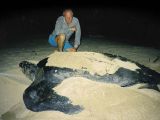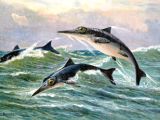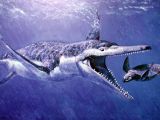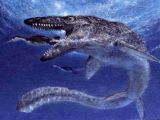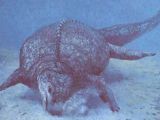Nowadays, the seas belong mainly to fish and sea mammals. But during the Mesozoic time, the sea was a reptilian realm. There are very few reptiles living in the sea now compared to the times of the dinosaurs.
1.Today, there are seven species of sea turtles. They appeared during the Jurassic period (200-150 Ma ago), thus they lived most of their evolutionary time together with the dinosaurs.
The largest living chelonian is the leatherback turtle (Dermochelys coriacea). The shell can even be over 3 m (10 ft) long (but rarely exceeds 2 m - 6.6 ft) and the animal can weigh from around 250 kg (600 pounds) to over one ton, being the largest living reptile. The span from one flipper to another is up to 9 ft (2.7 m).
The largest turtle ever was also a sea turtle: Archelon, a relative of the leatherback that inhabited the central North American Sea 70 Ma ago, at the end of the dinosaur era. The animal has a shell up to 13.5 ft (4 m) long, and a span, from flipper to flipper, of 16 ft (5.3 m), weighing over 4,500 pounds (2200 kg).
2.Amongst the monitor lizards, some species wander the shores looking for stranded corpses and even swim on brackish water. Some larger monitor lizards can even cross narrow sea straits.
But the only current lizard species that can be considered tightly connected to the sea is the marine iguana (Amblyrhynchus cristatus), a native of the Galapagos Islands. These lizards are peaceful vegetarians which dive and eat algae and weeds from the sea bottom, but also the plants exposed by the low tide.
Adult marine iguanas do not overpass 1.3 m (4.3 ft) in length, but each island of the archipelago has its type, with different sizes and colors. Males can weigh up to 3.5 kg (8 pounds). The Galapagos archipelago is not older than 5 million years and the iguanas surely came from South America, located 968 km (605 mi) away.
3.The proper sea snakes make 17 genera and 62 species. These venomous snakes represent sea relatives of the cobras. They are said to possess the most potent snake venom, but because of their low level of aggressiveness, human fatalities are rare.
The Laticauda sea snakes can still move sluggishly on the land (where they lay eggs); the other are not able to do this and give birth to living offspring. Sea snakes are found in warm coastal waters from the Indian Ocean to the Pacific. The tail resembles a paddle and many have laterally compressed bodies. These snakes rarely bypass 1.5 m (5 ft) in length and cannot be at the base of the legend of the "giant sea snake".
Many aquatic species of snakes can inhabit brackish coastal water, like the pile snakes (Acrochordidae) of southern Asia and northern Australia or Homalopsinae of the same area, both groups being non-venomous or mildly-venomous.
4.Amongst crocodilians, only crocodiles can enter the sea, while alligators and caymans are restricted to freshwater. That's because crocodiles have salt glands inside their mouths which allow them to stand sea water. That's why many crocodiles species abound in mangroves and estuaries.
In fact, the largest crocodile species is saltwater crocodile (Crocodylus porosus), encountered from India to northern Australia and Fiji. In can reach 7 m (23 ft) in length and 1 tonne in weight. At 5 m (17 ft) length, it already has 0.5 tonne. As its name says, it feels the same way in saltwater as in freshwater and this allowed it to have such a large area. The American crocodile (Crocodylus acutus) feels equally comfortable in sea water.
5.The most amazing reptiles that have ever wandered the seas were the Ichthyosaurs ('fish lizard' in Greek). They first appeared about 230 Ma ago and disappeared 90 Ma ago, before the dinosaur extinction 65 Ma ago, being replaced by plesiosaurs. Ichthyosaurs looked liked dolphins, but their limbs made 2 pair of flippers (in dolphins, the rear limbs are completely gone) and the fluke was orientated vertically, like the tail fin of the fish.
Most ichthyosaurs were 2-3 m (6.6-10 ft) long, but the largest species had up to 9 m (30 ft) in length. Some fossils were even found with embryos inside, thus they gave birth to live offspring.
6.Plesiosaurs were carnivorous marine) reptiles with flippers resembling those of the sea turtles and extremely long necks, bearing small heads. They appeared during the Jurassic (200-150 Ma ago) and went extinct at the same time with the dinosaurs.
Elasmosaurus, the longest plesiosaur, was 14 m (47 ft) long and weighed up to 2 tonnes. The plesiosaurs fit best with the story of the Loch Ness monster and the giant sea snake.
The pliosaurs were a distinct type of plesisosaur with short necks and large heads. They were more adapted to deep diving than ancient plesiosaurs, looking like a crocodile with turtle flippers.
Pliosaurs often preyed on smaller ichthyosaurs. The largest pliosaurs were up to 15 m (50 ft) long.
7.In fact, the largest reptiles that have ever roamed the seas still have living relatives. Mosasaurs, marine monsters from the dinosaur era, were relatives of the living monitor lizards. Some reached up to 17 m (57 ft) in length, as much as a humpback whale and were the most fearsome reptiles ever to enter the seas. Their limbs were transformed into flippers and clearly were the top predators of the seas during the Cretaceous. Their long, powerful jaws were endowed with conical sharp teeth and the capacity to open widely their mouth allowed them to engulf large chunks of food at a time. The body was elongated and they swam in the snake manner, using their powerful Tails. They went extinct at the same time with the dinosaurs.
8.Placodonts ("Tablet teeth") were stout bodied marine reptiles that lived during the Triassic period, before the emergence of the dinosaurs. They were 1-3 m (3.3-10 ft) long and looked like lizards or turtles. They inhabited shallow waters and consumed marine bivalves, brachiopods, and other invertebrates, crushing their shells with their specialized teeth.
9.The seals of the Mesozoic era were the Nothosaurs, contemporaneous to the placodonts. They were about 3 m (10 ft) long, with a long body and tail. The limbs were paddle-like and webbed. The sharp teeth pointed to a fish diet. These reptiles were replaced at the end of the Triassic by their offshoot, the plesiosaurs.
10.The first reptiles to go back to the sea after the fish had left it for the life on land (thus the first ever marine reptiles) were the mesosaurs ("middle lizards") which lived during the early Permian period, 320 to 280 million years ago in Namibia, Africa and parts of South America. They looked like small alligators, 0.4 to 2 m (1.3-6.6 ft) long. They consumed fish, or possibly crustaceans using their teeth like sieves the way whales use their baleens. These reptiles were closer to turtles amongst living reptiles.
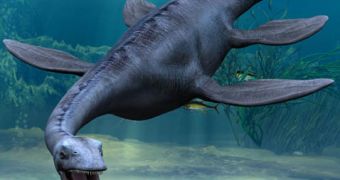
 14 DAY TRIAL //
14 DAY TRIAL // 
